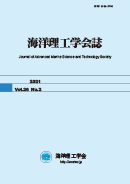Volume 26, Issue 2
Displaying 1-7 of 7 articles from this issue
- |<
- <
- 1
- >
- >|
Original Paper
-
2021 Volume 26 Issue 2 Pages 1-12
Published: September 30, 2021
Released on J-STAGE: September 30, 2021
Download PDF (2480K) -
2021 Volume 26 Issue 2 Pages 13-23
Published: September 30, 2021
Released on J-STAGE: September 30, 2021
Download PDF (17279K) -
Effects of Decreased pH of Seawater on the Growth of Sargassum horneri at Early Developmental Stages2021 Volume 26 Issue 2 Pages 25-36
Published: September 30, 2021
Released on J-STAGE: September 30, 2021
Download PDF (1971K)
Short Paper
-
2021 Volume 26 Issue 2 Pages 37-40
Published: September 30, 2021
Released on J-STAGE: September 30, 2021
Download PDF (1263K)
Technical Report
-
2021 Volume 26 Issue 2 Pages 41-46
Published: September 30, 2021
Released on J-STAGE: September 30, 2021
Download PDF (10862K)
Original Paper
-
2021 Volume 26 Issue 2 Pages 47-49
Published: September 30, 2021
Released on J-STAGE: September 30, 2021
Download PDF (407K)
-
2021 Volume 26 Issue 2 Pages 51
Published: September 30, 2021
Released on J-STAGE: September 30, 2021
Download PDF (125K)
- |<
- <
- 1
- >
- >|
